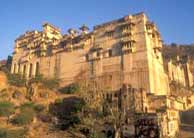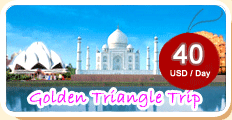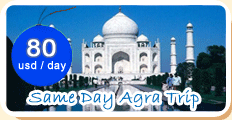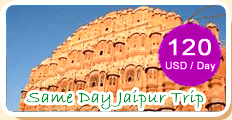
Bundi Tour

 Bundi is the undiscovered splendour, 36 Kms from Kota ruled by the Hada Chauhans. First destination is HADOTI. Set in a narrow inclining gorge. The palaces and forts have fairy tale quality about them. Isolated and independent, this picturesque location has much to offer. Rajput architecture shines and in the intricately carved brackets, pillars etc. Interesting places are Diwan-e- aam, Hathia Pol, and Naubat Khana.
Bundi is the undiscovered splendour, 36 Kms from Kota ruled by the Hada Chauhans. First destination is HADOTI. Set in a narrow inclining gorge. The palaces and forts have fairy tale quality about them. Isolated and independent, this picturesque location has much to offer. Rajput architecture shines and in the intricately carved brackets, pillars etc. Interesting places are Diwan-e- aam, Hathia Pol, and Naubat Khana.The Chitra SHALA has a colourful glimpse of history painted on ceilings and walls, making it an open art gallery. The paintings of Bundi School are famous for its festivals, animals and birds scenes portrayed beautifully.
During the state time Bundi was popular for hunting's and so are the hunting lodges like Phool Sagar Palace, Sukh Mahal and Shikar Burj.
TOURISTS ATTRACTIONS
Bundi is famous for its monuments and especially its fort, which preserves the glorious legacy of its erstwhile Rajput rulers. The Taragarh fort, built in 1354, with its imposing structure of stone, is situated on a steep hill and has massive battlements and ramparts. The fort welcomes the travellers through an enormous gateway. Once inside the fort, the traveller can see the Bhim Burj, the largest battlement, and a huge water reservoir carved out of solid rock. From the fort, one can see the entire town. Tourists also visit the fort to see sunsets. Bundi palace, which is situated on a hill, adjacent to the Taragarh fort, is known for its traditional murals. These murals give the traveller a glimpse of the splendor and lifestyle of the rulers of Bundi and their exploits. Though most parts of the palace walls are decorated with traditional murals, only the Chitra Shala area is open for the tourist. Special permission has to be obtained to see the frescoes in other parts of the palace. Bundi is famous for its waterworks. It has a number of impressive baolis or step wells. Raniji-ki-Baoli, (Queen's step well) is an important place to visit. It is a 46-m-deep step well, built in 1699 by Queen Nathavatji, and is known for its carvings. The Nagar Sagar Kund, a pair of identical, step wells is near Raniji-ki-Baoli, in the center of the town. Nawal Sagar, the artificial lake near the palace is a good tourist spot and one can see a shrine at the center of this lake. Other waterworks worth visiting are Dhabhai Kund and Bhora-ji-ka-Kund. Other places of tourist importance are the Sabzi Mandi (vegetable market) within the old town. An 84-pillared cenotaph is situated at the southern end of the town within a well-laid garden, near the railway station. It is worth visiting at night when the monument is lit up.
PLACES AROUND BUNDI
There are many tourist attractions near the town. Phool Sagar Palace, a modern palace built in the 20th century, with its well-laid gardens and artificial tanks, is several kilometers from the town, on the way to Ajmer. The Sukh Mahal Palace is 2 km north of the town near the Jait Sagar Lake. The Sar Bagh, with its royal cenotaphs and intricate carvings, and the Shikar Burj, a small royal hunting lodge adjacent to the Jait Sagar Lake, are other nearby places worth visiting. Garardha village, 32 km south of Bundi, is known for its ancient rock paintings that are about 15,000 years old.
FAIRS & FESTIVALS
Bundi is famous for its Kajli-teej festival. This annual festival is held in July-August. Travellers must make it a point to visit Bundi during this festival.
HOW TO REACH
BY RAIL - Bundi does not have an airport. It has a small railway station located to the south of the town. Bundi is well connected with Agra and Kota by trains. One can also catch trains from Kota, which is 36 km from Bundi and is an important railhead.
BY ROAD - Bundi is also well linked by bus with Ajmer (5 hours), Kota (1 hour), Udaipur (9 hours) and Jaipur (5 hours). The main bus stand is 1 km north of the railway station. One can move around the town using auto-rickshaws and take taxis to visit places around. Bikes are also available on hire.
Phool Sagar
The PHOOL SAGAR is an excellent and well-planned structure as also the decoration of this Rajput edifice, and the same beauty lies in the massive TARAGARH. This little town has yet retained a medieval atmosphere. Bundi is not exactly a tourist tramping ground but never the less, this adds on to its appeal with a curiosity to explore it. The look of the town has a Bluish hue same as that of Jodhpur. With no renovating desire, the art is in a crumbling state of disrepair. The original history claims that Bundi was once the capital of the great HADOTI KINGDOM. But then KOTA in 1624 was separated as an independent state and thus the journey of Bundi downfall started.
A prominent author approached BUNDI, He came, He saw and He created RUDYARD KIPLING's inspiration took birth in the state of Bundi and so inspired was he by the enchanting set up that he captured its images and applied them to his works.
Taragarh fort
It was built in 1345 and is great ramble around at leisure. This is rather a ramshackle fort, with its overgrown vegetation.
The view over the town and surrounding countryside from the top are magical, especially at sun set. Inside the ramparts are huge reservoirs carved out of solid rock, and the Bhim Burj, the largest of the battle- fields, on which there is mounted a famous cannon. Taragarh is reached by steep road leading up the hillside to its enormous gateway. Take a path up behind the chitra Shala, go east along the inside of the ramparts then left up the steep stone ramp just before the Dudha Mahal, a small disused building 200m from the palace.
























